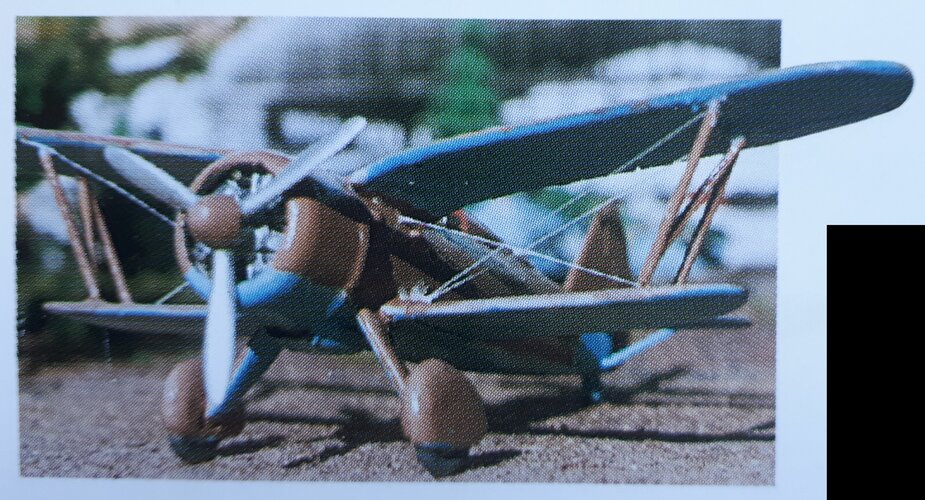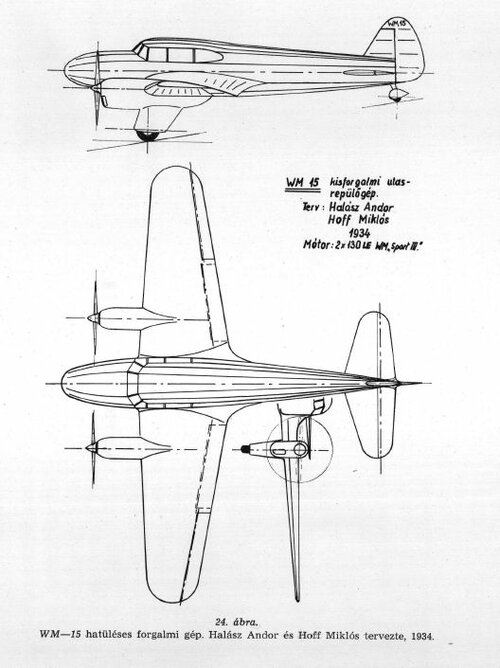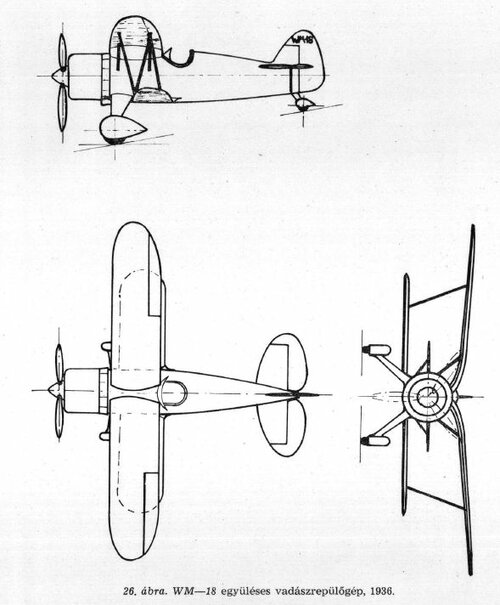You are using an out of date browser. It may not display this or other websites correctly.
You should upgrade or use an alternative browser.
You should upgrade or use an alternative browser.
Question about Weiss WM-17 & WM-18
- Thread starter hesham
- Start date
HelloHi,
the Hungarian company Weiss,designed two projects,the
WM-17 & WM-18,both of them considered as single-seat
fighter,has anyone more info or drawings to them ?.
I am also looking for information on these planes. All I could find on the subject is two sources, still available on some Hungarian online bookstores, but difficult to get because of the language barrier:
- Fejetek a magyar katonai repülés történetéböl (collective work, 1986): the WM 17 and 18 are described as two fighter projects, one with Gnôme Rhone (manufactured by Weiss Manfred) K7 and K14 engines respectively
- Magyar repülok, repülo magyarok (Winkler Laslo, 2000): two small photos of models of the WM15 (light transport aircraft resembling an Avro Anson with fixed landing gear), and a WM 18 (vaguely resembling a hybrid between a large IMAM Ro41 and a PZL P11 (Pulavski type upper wing)
I didn't find anything else, but if there are models, there must be plans somewhere ;-)
Translated with www.DeepL.com/Translator (free version)
- Joined
- 26 May 2006
- Messages
- 32,683
- Reaction score
- 11,907
Welcome aboard Geoliege,
and gret find,it means;
- Chapters from the history of Hungarian military aviation (collective work, 1986): the WM 17 and 18 are described as two fighter projects, one with Gnôme Rhone (manufactured by Weiss Manfred) K7 and K14 engines respectively
- Hungarian flights, flying Hungarians (Winkler Laslo, 2000): two small photos of models of the WM15 (light transport aircraft resembling an Avro Anson with fixed landing gear), and a WM 18 (vaguely resembling a hybrid between a large IMAM Ro41 and a PZL P11 (Pulavski type upper wing)
and gret find,it means;
- Chapters from the history of Hungarian military aviation (collective work, 1986): the WM 17 and 18 are described as two fighter projects, one with Gnôme Rhone (manufactured by Weiss Manfred) K7 and K14 engines respectively
- Hungarian flights, flying Hungarians (Winkler Laslo, 2000): two small photos of models of the WM15 (light transport aircraft resembling an Avro Anson with fixed landing gear), and a WM 18 (vaguely resembling a hybrid between a large IMAM Ro41 and a PZL P11 (Pulavski type upper wing)
- Joined
- 25 July 2007
- Messages
- 3,873
- Reaction score
- 3,176
Great first post geoliege!
A 'fighter' powered by a 350-400 hp engine seems rather implausible. AFAIK, Manfred Weiss never license-built the Gnome-Rhône 7K. Was this licensed production of the Titan Major simply an unrealized plan? Or is 'K.7' a typo?
I'm wondering if that source had not mistaken this 'K.7' for the Manfred Weiss-licensed K.9 (Gnome-Rhône 9K). Even still, that 550 hp 9-cylinder radial wouldn't result in much of a 'fighter'. Winkler's IMAM Ro.41 reference intrigues. Might that comparison be better applied to the WM-17? In other words, could the WM-17 have actually been a lower-powered, single-seat, fighter-trainer variant of the WM-18?
A 'fighter' powered by a 350-400 hp engine seems rather implausible. AFAIK, Manfred Weiss never license-built the Gnome-Rhône 7K. Was this licensed production of the Titan Major simply an unrealized plan? Or is 'K.7' a typo?
I'm wondering if that source had not mistaken this 'K.7' for the Manfred Weiss-licensed K.9 (Gnome-Rhône 9K). Even still, that 550 hp 9-cylinder radial wouldn't result in much of a 'fighter'. Winkler's IMAM Ro.41 reference intrigues. Might that comparison be better applied to the WM-17? In other words, could the WM-17 have actually been a lower-powered, single-seat, fighter-trainer variant of the WM-18?
Yes, this is probably the case, probably following the same principle as the WM16, declined in "Budapest 9" and "Budapest 16" versions. The hypothesis of a training version is plausible.
I am not sure if I can publish the text extract on the forum (moderator?), but the book does mention a "K7" engine, but indeed K9 would be more logical.
That said, the only information available to me is this (too) small photo of a model from the late Laszlo Winkler's collection, which suggests a shape close to a Ro41 (or indigenous AVIS?) with a gull-shaped upper wing and huge cowlings, but with a low quality and without plan, dimensions and scale, it's hard to do better
In order not to break the forum rules, I can send you a scan of this picture by private message, but it is really of little help
That said, in the same book, it is also mentioned CR32 and Heinkel 51 experimentally fitted with K14 (but not the K14-powered CR42 testbed which was truly tested), Hungarian Dewoitine D520 and early variants of FW190, which is doubtful to me, so what about this interpretation of WM15 and WM17/18?
Moreover, the photographs of these models do not appear anymore in later publications from or related to the author.
I am not sure if I can publish the text extract on the forum (moderator?), but the book does mention a "K7" engine, but indeed K9 would be more logical.
That said, the only information available to me is this (too) small photo of a model from the late Laszlo Winkler's collection, which suggests a shape close to a Ro41 (or indigenous AVIS?) with a gull-shaped upper wing and huge cowlings, but with a low quality and without plan, dimensions and scale, it's hard to do better
In order not to break the forum rules, I can send you a scan of this picture by private message, but it is really of little help
That said, in the same book, it is also mentioned CR32 and Heinkel 51 experimentally fitted with K14 (but not the K14-powered CR42 testbed which was truly tested), Hungarian Dewoitine D520 and early variants of FW190, which is doubtful to me, so what about this interpretation of WM15 and WM17/18?
Moreover, the photographs of these models do not appear anymore in later publications from or related to the author.
OK, I will scan both text and photo and post it soon
But I think I got the solution from the forum itself : the WM18 general layout shown on the photo is very close to Fiat CR41 similarly powered prototype:
But I think I got the solution from the forum itself : the WM18 general layout shown on the photo is very close to Fiat CR41 similarly powered prototype:
- Joined
- 26 May 2006
- Messages
- 32,683
- Reaction score
- 11,907
OK, I will scan both text and photo and post it soon
But I think I got the solution from the forum itself : the WM18 general layout shown on the photo is very close to Fiat CR41 similarly powered prototype:
OK and thanks.
- Joined
- 25 July 2007
- Messages
- 3,873
- Reaction score
- 3,176
Hello again ...
A machine translation roughly tweaked:
It is worth mentioning that as early as March 1933, the possibility arose of developing a fighter type powered by these engines. Approval went primarily to the WM factory, where the WM 17 and the WM 18 biplanes were being designed - one intended for the K 9 engine, the other for the K 14. Engineers Anderlik Elöd and Laszlo Varga also pursued the basic design of a wooden-structured, K-engine fighter - the AVIS - within their own engineering department. Six were produced at Székesfehérvár-Sóstan. In the 1935 letter of the LÜH: [...]
The Google Translate version was a bit funky. AFAIK, kétszárnyú just means 'two wings'. I've retained the text's all-caps "LÜH" although, properly, that should be LüH (for Légüyi Hivatal).
- Joined
- 26 May 2006
- Messages
- 32,683
- Reaction score
- 11,907
I got it!
from Technikatörténeti szemle 4. (1967)
Amazing drawings,thanks.
can be found here https://library.hungaricana.hu/hu/view/ORSZ_KOZL_TechnTortSzle_04/?pg=166&layout=sI got it!
from Technikatörténeti szemle 4. (1967)
- Joined
- 26 May 2006
- Messages
- 32,683
- Reaction score
- 11,907
can be found here https://library.hungaricana.hu/hu/view/ORSZ_KOZL_TechnTortSzle_04/?pg=166&layout=sI got it!
from Technikatörténeti szemle 4. (1967)
Hi,
WM—15 six-seater traffic machine. It was designed by: Andor Halász, with the strong cooperation of Miklós Hoff, who replaced the then ill chief designer in his work. Later, this type was also listed in the factory's records as a Hoff traffic machine. Although no data is available about this machine, it is known that its plans were fully developed, and even its experimental parts were completed (e.g. the special main support system with a cabinet). This is also proven by the fact that his model was also exhibited in the old Budapest Transportation Museum in the (destroyed) display case displaying the products of the WM factory. In terms of its general layout, it has a lower wing, two WM Sport—III. it was a streamlined machine with a motor and trapezoidal surfaces. Its undercarriage was lowered into the streamlines starting from the engine cover and the wing trunk transition was carefully rounded. In the absence of exact data about the model in the mentioned WM showcase, the main dimensions deduced in a scale appropriate to the engine are as follows: Estimated span: 16.2 m, length: 13 m, height: 3.8 m.
The WM-17 is a single-seat fighter aircraft. At the same time as the birth of the ÁVIS types, around 1934, the WM factory was also engaged in the development of domestically produced fighter aircraft types. Andor Halász designed two kites for the then new K-14 engine. More details about the WM-17 machine are currently unknown, we only know that it was a biplane, stiffened machine, and only its plans were completed.
The WM-18 is a single-seat fighter aircraft. It was completed according to the plans of Andor Halász. The factory exhibited it in the aforementioned Transport Museum showcase. It was a nicely streamlined, stocky machine, with gull-shaped upper wings directly attached to the fuselage to give the pilot a good view. Its undercarriage was wrapped in a streamlined manner and connected to the body structure with a streamlined support. Béla Samu, later chief designer, was already working on the plane's wing structure and it was made with the new tube main support, which bent when it joined the fuselage. The informational data of WM-18 measured back from the photograph were as follows: F: 9.8 m, h: 8 m, m: 3.7 m, engine: WM-K-14. Year of construction 1936.
WM—19 touring machine. Andor Halász's plans for the machine were registered in the drawing library of the WM factory, but the plans and there are no data on the completion of the machine.
WM—20 biplane, two-seat training machine. Gnome-Rhone "Titán" with 5-cylinder, 240 Lens engine. Designed by Andor Halász and Miklós Hoff (1935). This machine in fact, the Heinkel HD-22 was created as an upgrade of military training machines, but the original Heinkel designs were thoroughly revised and only the main dimensions were kept in accordance with the HD-22. This machine was also exhibited in the WM showcase, but there are also data on its construction and flight. A copy of it was still in operation in 1938, at the Budaörs airport. Features: double-deck, stiffened wing, with rounded surfaces. The trunk has an oval cross-section, N.A.C.A. with engine cover ring. The steering surfaces are elliptical in shape. Its running gear is split, with streamlined wheel covers. The main dimensions of the plane (based on measurements from the photo): f: 12 m, h: 8.50 m, wing area: 31 m 2 , m: 3.5 m. The plane's marking was first HA-PTA, then in the air force group G-100.
WM—22 reconnaissance bomber. At the request of the air force, Béla Samu laid down the basic plans for a high-wing, multi-task reconnaissance aircraft for the WM-14/A engine, but his design was later stopped. At this time, a new group of constructors was organized in WM's design in addition to the old ones in the person of István Lajtai, Vilmos Marton, Márton Pap, Jenő Pavláth, János Weingartner and others, with whom Béla Samu took on the task of creating a fully Hungarian designed and built fighter to eliminate the previous foreign dependence. develops:
Similar threads
-
-
Weiss Manfred XNI-2 Kamelean
- Started by robertino
- Replies: 0
-
-
-




